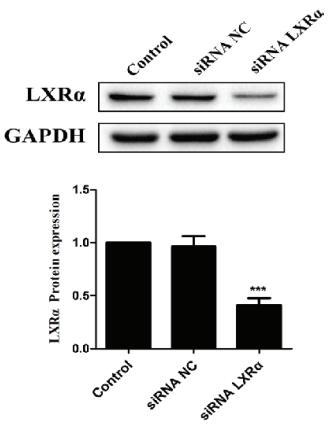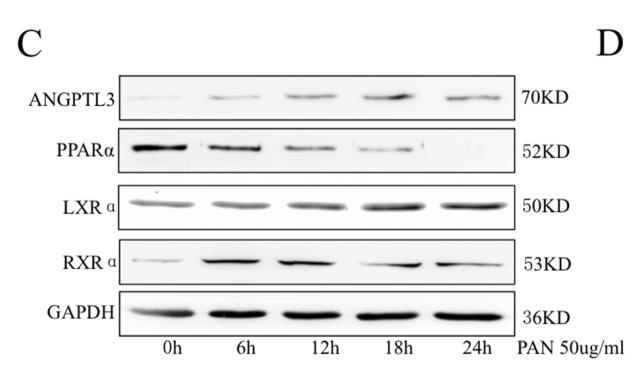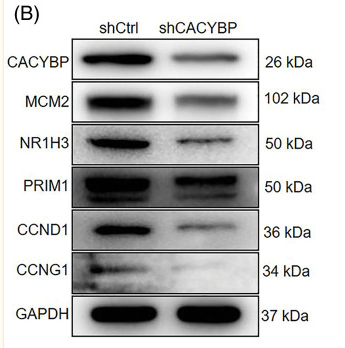NR1H3 Antibody - #DF6864
製品説明
*The optimal dilutions should be determined by the end user. For optimal experimental results, antibody reuse is not recommended.
*Tips:
WB: For western blot detection of denatured protein samples. IHC: For immunohistochemical detection of paraffin sections (IHC-p) or frozen sections (IHC-f) of tissue samples. IF/ICC: For immunofluorescence detection of cell samples. ELISA(peptide): For ELISA detection of antigenic peptide.
引用形式: Affinity Biosciences Cat# DF6864, RRID:AB_2838823.
折りたたみ/展開
Liver X receptor alpha; LXR a; LXRA; NR1H3; NR1H3_HUMAN; Nuclear receptor subfamily 1 group H member 3; Oxysterols receptor LXR alpha; Oxysterols receptor LXR-alpha; RLD 1; RLD1;
免疫原
A synthesized peptide derived from human NR1H3, corresponding to a region within C-terminal amino acids.
Visceral organs specific expression. Strong expression was found in liver, kidney and intestine followed by spleen and to a lesser extent the adrenals.
- Q13133 NR1H3_HUMAN:
- Protein BLAST With
- NCBI/
- ExPASy/
- Uniprot
MSLWLGAPVPDIPPDSAVELWKPGAQDASSQAQGGSSCILREEARMPHSAGGTAGVGLEAAEPTALLTRAEPPSEPTEIRPQKRKKGPAPKMLGNELCSVCGDKASGFHYNVLSCEGCKGFFRRSVIKGAHYICHSGGHCPMDTYMRRKCQECRLRKCRQAGMREECVLSEEQIRLKKLKRQEEEQAHATSLPPRASSPPQILPQLSPEQLGMIEKLVAAQQQCNRRSFSDRLRVTPWPMAPDPHSREARQQRFAHFTELAIVSVQEIVDFAKQLPGFLQLSREDQIALLKTSAIEVMLLETSRRYNPGSESITFLKDFSYNREDFAKAGLQVEFINPIFEFSRAMNELQLNDAEFALLIAISIFSADRPNVQDQLQVERLQHTYVEALHAYVSIHHPHDRLMFPRMLMKLVSLRTLSSVHSEQVFALRLQDKKLPPLLSEIWDVHE
種類予測
Score>80(red) has high confidence and is suggested to be used for WB detection. *The prediction model is mainly based on the alignment of immunogen sequences, the results are for reference only, not as the basis of quality assurance.
High(score>80) Medium(80>score>50) Low(score<50) No confidence
研究背景
Nuclear receptor that exhibits a ligand-dependent transcriptional activation activity. Interaction with retinoic acid receptor (RXR) shifts RXR from its role as a silent DNA-binding partner to an active ligand-binding subunit in mediating retinoid responses through target genes defined by LXRES (By similarity). LXRES are DR4-type response elements characterized by direct repeats of two similar hexanuclotide half-sites spaced by four nucleotides (By similarity). Plays an important role in the regulation of cholesterol homeostasis, regulating cholesterol uptake through MYLIP-dependent ubiquitination of LDLR, VLDLR and LRP8. Interplays functionally with RORA for the regulation of genes involved in liver metabolism (By similarity).
Ubiquitinated leading to its degradation by the proteasome.
Nucleus. Cytoplasm.
Visceral organs specific expression. Strong expression was found in liver, kidney and intestine followed by spleen and to a lesser extent the adrenals.
Belongs to the nuclear hormone receptor family. NR1 subfamily.
研究領域
· Human Diseases > Endocrine and metabolic diseases > Insulin resistance.
· Human Diseases > Endocrine and metabolic diseases > Non-alcoholic fatty liver disease (NAFLD).
· Human Diseases > Infectious diseases: Viral > Hepatitis C.
· Organismal Systems > Endocrine system > PPAR signaling pathway.
参考文献
Application: WB Species: human Sample: HepG2 cells
Application: WB Species: Mouse Sample: podocytes
Application: WB Species: Mouse Sample:
Restrictive clause
Affinity Biosciences tests all products strictly. Citations are provided as a resource for additional applications that have not been validated by Affinity Biosciences. Please choose the appropriate format for each application and consult Materials and Methods sections for additional details about the use of any product in these publications.
For Research Use Only.
Not for use in diagnostic or therapeutic procedures. Not for resale. Not for distribution without written consent. Affinity Biosciences will not be held responsible for patent infringement or other violations that may occur with the use of our products. Affinity Biosciences, Affinity Biosciences Logo and all other trademarks are the property of Affinity Biosciences LTD.






